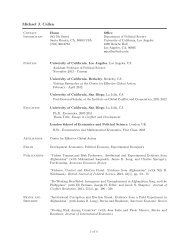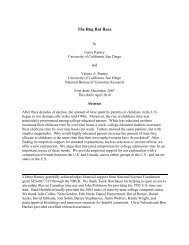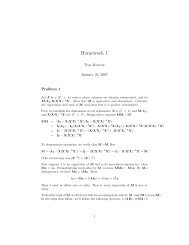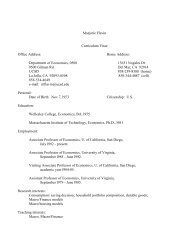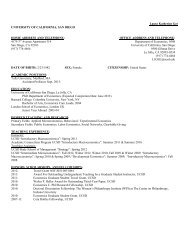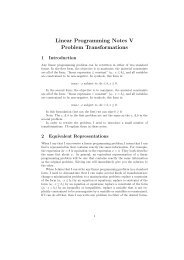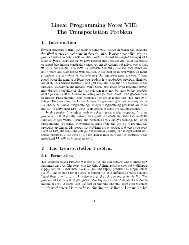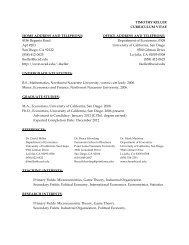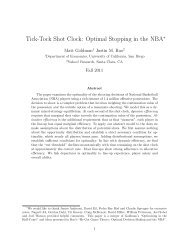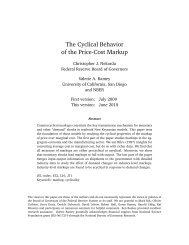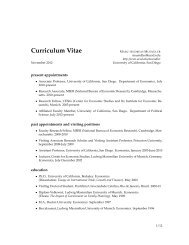Endogenous derivation of 'money' - UC San Diego Department of ...
Endogenous derivation of 'money' - UC San Diego Department of ...
Endogenous derivation of 'money' - UC San Diego Department of ...
Create successful ePaper yourself
Turn your PDF publications into a flip-book with our unique Google optimized e-Paper software.
456 R. M. Starr<br />
“[An] important and difficult question...[is] not answered by the approach<br />
taken here: the integration <strong>of</strong> money in the theory <strong>of</strong> value...”<br />
Gerard Debreu, Theory <strong>of</strong> Value (1959)<br />
1 Money in Walrasian general equilibrium<br />
Consider four commonplace observations on the character <strong>of</strong> trade in virtually all<br />
economies:<br />
(i) Trade is monetary. One side <strong>of</strong> almost all transactions is the economy’s common<br />
medium <strong>of</strong> exchange.<br />
(ii) Money is (virtually) unique. Though each economy has a ‘money’ and the<br />
‘money’ differs among economies, almost all the transactions in most places<br />
most <strong>of</strong> the time use a single common medium <strong>of</strong> exchange.<br />
(iii) ‘Money’ is government-issued fiat money, trading at a positive value though<br />
it conveys directly no utility or production.<br />
(iv) Even transactions displaying a double coincidence <strong>of</strong> wants are transacted<br />
with money. 1<br />
Where economic behavior displays such uniformity, a general elementary economic<br />
theory should be able to account for the universal usages. But (i), (ii), and (iii)<br />
contradict the implications <strong>of</strong> a frictionless Walrasian general equilibrium model,<br />
and (iv) contradicts the conventional view <strong>of</strong> the role <strong>of</strong> money with regard to the<br />
double coincidence <strong>of</strong> wants. This essay presents a class <strong>of</strong> examples with a slight<br />
modification <strong>of</strong> the Arrow-Debreu general equilibrium model sufficient to derive<br />
points (i)–(iv) as outcomes. In doing so, this essay responds to a challenge expressed<br />
by Tobin (1980)<br />
Social institutions like money are public goods ... General equilibrium<br />
theory is not going to explain the institution <strong>of</strong> a monetary ... common<br />
means <strong>of</strong> payment.<br />
Thus the examples below are intended to show that a general equilibrium model<br />
can explain endogenously from price theory the institution <strong>of</strong> a common monetary<br />
means <strong>of</strong> payment. 2 The price system itself designates ‘money’ and guides transactors<br />
to trade using ‘money.’ The model emphasizes complete markets and complete<br />
1 University <strong>of</strong> California faculty whose children are enrolled at the University pay fees in money,<br />
not in kind; Ford employees buying a Ford car pay in money, not in kind; Albertson’s supermarket<br />
checkout clerks acquiring groceries pay in money, not in kind. This observation suggests that the focus<br />
on the absence <strong>of</strong> double coincidence <strong>of</strong> wants – as distinct from transaction costs – as an explanation<br />
for the monetization <strong>of</strong> trade may miss a significant part <strong>of</strong> the underlying causal mechanism.<br />
2 A bibliography <strong>of</strong> the issues involved in this inquiry appears in Ostroy and Starr (1990). In addition,<br />
note particularly Banerjee and Maskin (1996), Hellwig (2000), Howitt (2000), Howitt and Clower<br />
(2000), Iwai (1996), Kiyotaki and Wright (1989), Marimon et al. (1990), Rajeev (1999), Rey (2001),<br />
Trejos and Wright (1995), and Young (1998). The treatment <strong>of</strong> transaction costs in this essay (as opposed<br />
to the recent focus in the literature on search and random matching equilibria) resembles the general<br />
equilibrium models with transaction cost developed in Foley (1970); Hahn (1971); Starrett (1973), and<br />
Kurz (1974). The structure <strong>of</strong> bilateral trade here however is more detailed, with a budget constraint<br />
enforced on each transaction separately, so that the Foley, Hahn, and Starrett models do not immediately<br />
translate to the present setting.




